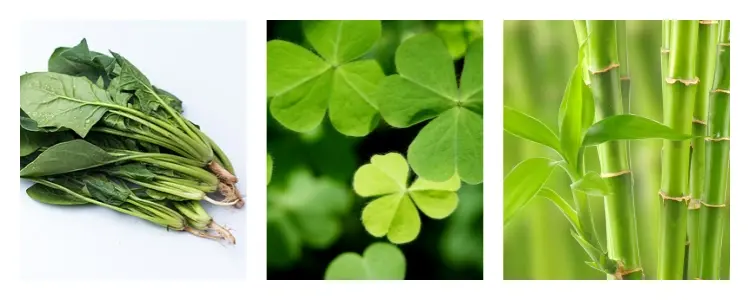Is Sodium Magnesium Chlorophyll Good for You?
Is Sodium Magnesium Chlorophyll Good for You?
What is sodium magnesium chlorophyllin?
Sodium copper chlorophyllin is a natural pigment extracted from plant chloroplasts and processed by chemical methods. Its main component is chlorophyll derivatives. Sodium magnesium chlorophyllin belongs to porphyrin compounds in chemical structure. This substance is easily soluble in water, slightly soluble in alcohol, and insoluble in oil. It is transparent in aqueous solution and no precipitation is produced.
The source of sodium magnesium chlorophyllin is mainly chlorophyll in plant chloroplasts. After a series of chemical treatments and processing, a stable sodium magnesium chlorophyllin is formed. Because it is extracted from plants, it has the characteristics of natural, safe, and non-toxic. At the same time, it also has good biocompatibility and stability, and is not easily oxidized or decomposed during use.
What is the function of sodium magnesium chlorophyll?
Sodium magnesium chlorophyll is a substance necessary for plants to carry out photosynthesis. As one of the key pigments involved in photosynthesis, it converts carbon dioxide and water into organic matter and releases oxygen by absorbing the energy of sunlight. This is the basis for plant survival and growth.
Sodium magnesium chlorophyll is often used as a natural colorant in the food industry to provide a natural green color for food, such as green candy, ice cream, cakes, etc. Its green color is natural and lasting, which meets the pursuit of natural food by modern consumers. The aqueous solution of sodium magnesium chlorophyll is transparent and precipitate-free and easily soluble in water. These characteristics make it suitable for use in the food industry.
The magnesium ions and iron ions in sodium magnesium chlorophyll help promote the production of hemoglobin, and have a certain blood-tonifying effect on patients with iron deficiency anemia.
Sodium magnesium chlorophyll can combine with harmful substances in food such as pesticides and heavy metals, reduce their absorption in the human body, and thus play a detoxifying role.
Chlorophyll magnesium sodium salt has strong antioxidant properties, which can remove free radicals in the body, delay aging and enhance immunity.
How is sodium magnesium chlorophyll extracted?
The first step in extracting chlorophyll is to select natural plants rich in chlorophyll as raw materials. These plants may include spinach, clover, alfalfa, bamboo, etc. Next, these plants are crushed under specific conditions to better extract chlorophyll. During the extraction process, some chemical solvents, such as acetone or petroleum ether, and additives such as calcium carbonate are usually used to help extract chlorophyll.
The extracted chlorophyll is not the final product, and it needs to go through a series of refining processes. This includes removing impurities, adjusting the pH value, and converting the extracted chlorophyll into a more stable sodium copper chlorophyll salt through chemical reactions such as saponification and copperization.
In addition to sodium copper chlorophyll salt, other chlorophyll derivatives, such as sodium magnesium chlorophyll salt, can be further derived from chlorophyll extracts. This process involves more complex chemical reactions and refining steps, which require professional technology and equipment to complete.

What is the role of magnesium chlorophyll sodium salt in cosmetics?
Magnesium Chlorophyll Sodium Salt acts as a colorant to provide a natural green hue in cosmetics. It has good tinting power and beautiful color, giving cosmetics a natural and healthy appearance. The use of this pigment not only satisfies consumers' pursuit of natural and healthy products, but also provides cosmetics manufacturers with diverse choices.
Magnesium chlorophyll sodium salt is rich in chlorophyll, which has the ability to resist oxidation and scavenge free radicals in the body. In cosmetics, these properties can help fight skin aging and pigmentation and reduce skin damage caused by environmental factors. By using sodium magnesium chlorophyll, cosmetics can provide the skin with additional protection against cell damage, thus maintaining the health and vitality of the skin.
Magnesium chlorophyll sodium salt, as a metal porphyrin, has high stability, which makes its application in cosmetics more reliable. Its color and performance will not change significantly even when exposed to harsh environments such as light and temperature changes. This stability is a very important property in the cosmetics industry as it ensures the color persistence and long-term effects of the product.
Magnesium chlorophyll sodium salt, as a natural pigment, is considered a relatively safe additive. It has been approved for use in food and cosmetics by health organizations in many countries, and its low toxicity further increases its confidence in its application in the field of cosmetics. Consumers do not need to worry too much about safety issues when using cosmetics containing magnesium chlorophyll sodium salt.
What is the difference between magnesium sodium chlorophyll and other pigments?
Compared with other pigments, magnesium sodium chlorophyll is different mainly in terms of source, structure, color and stability.
First of all, magnesium sodium chlorophyll is a natural pigment derived from natural plants rich in chlorophyll, which is extracted, refined and purified. Other pigments may come from synthetic chemicals or different natural resources.
Secondly, in terms of chemical structure, magnesium sodium chlorophyll belongs to porphyrin compounds with a specific ring structure, which gives it unique color and light absorption characteristics. Other pigments such as carotenoids and anthocyanins have different chemical structures from magnesium sodium chlorophyll, so their colors and functions are also different.
In terms of color, magnesium sodium chlorophyll is yellow-green, while other pigments such as copper sodium chlorophyll are dark green. In addition, magnesium sodium chlorophyll is transparent and precipitated in aqueous solution, while some pigments may be insoluble in water or present different solubility states.
Finally, sodium magnesium chlorophyll is used in photodynamic sterilization, and its photosensitizer is mainly porphyrin compounds and their derivatives. In contrast, other pigments may not have such functions or have different application fields.
_1737093401309.png)
